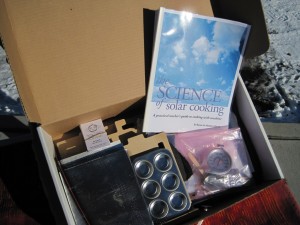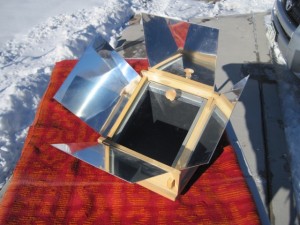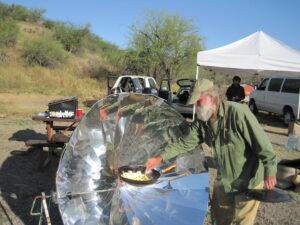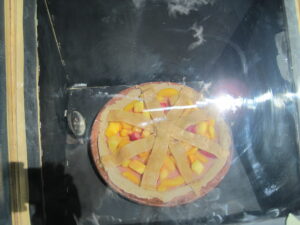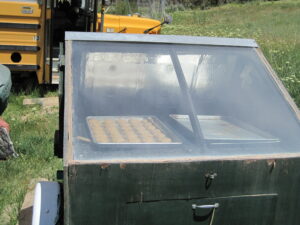Our new Solar Oven Kit comes complete with The Science of Solar Cooking learning booklet. Explore the science of heat transfer with hands-on lessons on convection, conduction, radiation, insulation, orientation, transmission and more. Read about the History of Solar Cooking and do all the exercises included in the booklet.
This kit is perfect for the classroom and for home schoolers as well. No tools necessary. Loads of fun. You will actually be cooking in this mini solar oven that is large enough to fit a standard size pot pie.
Our Sun Solar recommends two kits per classroom. The kit can be utilized by one student as well. The kit will cost $250 plus shipping.
THE ABOVE SOLAR OVEN KIT IS NOT AVAILABLE AT THIS TIME.
OUR SUN SOLAR DESIGNS AND BUILDS CUSTOM SOLAR OVENS TO MEET ALL YOUR COOKING NEEDS!
INTERESTING AND IMPORTANT FACTS ON SOLAR COOKING
In just a few days, the sun showers us with energy equal to all the earth’s fossil fuels. Consider our environment and its condition; using solar energy seems only logical. One way to use the sun is to cook with the energy. We can bake, fry, steam, or even solarque our favorite dish right in our own backyard.
Brief History
Successful solar cookers were reported in Europe and India as early as the 18th century. The increased use of glass during that period helped inventors to trap heat & hot air. In 1870, Augustine Mouchot invented a fairly portable oven for the French Foreign Legion. It could bake a pound of bread in 45 minutes or 2 pounds of potatoes in one hour.
Around the same time, W. A. Adams developed an eight-sided mirrored oven which reflected light through a glass cone located in the center of the oven. This oven could cook a 12 pound turkey in 4 to 5 hours. This is still a popular design today. We actually use a large model, very similar to Adam’s oven. In this oven we can cook 60 pounds of food at a time.
Present Times
Interest in solar energy seems to fluctuate along with the price of fuels (oil in particular). We feel a new awareness is
blooming. It is due to the ever growing concerns about OUR planet EARTH and our desire to help Earth out! Solar cooking enables us to contribute in a small, simple way.
How It Works
Sunlight is concentrated in a cooking area by using mirrors or any reflective surface. Consider a car parked in the sun with all the windows up. The sunlight is absorbed as heat by the car’s interior. The rolled up windows help keep the heat and hot air within the car. In a solar oven heat is captured inside an enclosed area and is absorbed by the food and pots or ans. This is called the greenhouse effect and applies to cars, solar cookers and planets. In solar ovens, temperatures as high as 425°F can be achieved.
Solar Ovens
Ovens come in many shapes and sizes. For example there are: box ovens • slant-faced • multi-mirrored • four sided pyramids…… This list could go on forever. Designs vary, but all OVENS trap heat in some form of insulated compartment. In most of these designs the sun actually strikes the food. It is pleasing that the sun’s energy is absorbed by the food we eat.
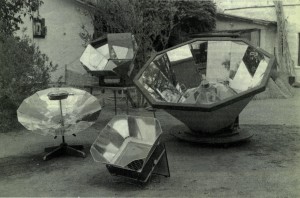
Our Favorite Oven
The Slant-Faced Oven. We use 3 of these, along with other designs. One nice feature of this oven is that it works in the winter. For the avid solar cooker, this is essential to roast the Christmas turkey! Its ease of construction is nice too. You can vary from the design readily, so you can use available materials. The oven is fairly portable and very durable. The compartment size can be nice and big too. This design is capable of exceeding 400°F. They generally cook at 325°F to 350°F.
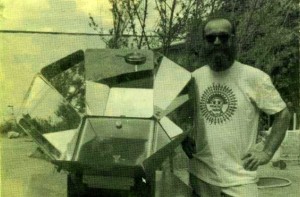
Solar Cookers & Steamers
Cookers or hot-plates concentrate light on a focal point. They are used for frying or by holding the food in the focal point (like a hot dog on a stick). Use caution with a cooker, especially when children are around. Intensified light can cause fires, burns and be harmful to the eyes. Steamers work just like they sound. The cooker’s heat boils water to make steam, which cooks the food. I have seen designs that are just a solar hot water collector. Simply directing steam to a box with a relief valve on it. Just like a pressure cooker, except the sun provides the power.
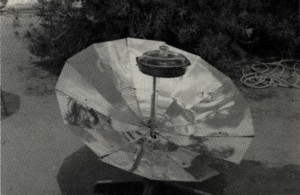
Facts on Constructing Solar Ovens & Cookers
There are some important facts to know when building a solar oven. One is to: GO FOR IT. Don’t be afraid to experiment. That is how progress is made.
• When choosing insulation, be sure to use insulation that will not out-gas. Ask your supplier if the insulation can handle high temperatures. Some will actually break down at 250°F and lose their insulation capability. Stay away from ALL foam type insulation. We recommend duct-board insulation or some hard cardboard. Duct board is made of pressed fiberglass with strong, waffle-like foil on one side. Regular fiberglass insulation works fine also. Just be sure to cover it some how, insulation tastes horrible. Currently Our Sun Solar is using cardboard in the Solar Oven Kit.
• Paint the inside of your oven black with non-toxic, lead free paint. A good paint is equal parts of black tempera powder, white glue and water. Simply mix together and brush on. This is what the Solar Oven Kits has.
• Use dark cooking containers. Stay away from shiny pots & pans which reflect light instead of absorbing it. We use cast iron pots with glass lids. Cast iron cooks well and retains heat. With the glass top, you actually have an oven inside of an oven and you can see your food cooking. Is is advised to have your utensil on a small cooking rack. This way heat can surround the pot or dish for better performance.
• Cooking bags can be used for those bigger foods, such as turkeys, roasts, etc. They are very durable and can be purchased at most markets. Be sure not to tie these real tight as they expand when the heat can’t escape.
• Good reflectors are very important. Make your reflector surface as large as the area you are reflecting into. Reflectors can be made out of aluminum foil, reflective mylar, glass mirror, polished aluminum, stainless steel or any item that reflects light well. Mirrors qualify as the best because you can clean glass easily and repeatedly. This is a strong point, although they are cumbersome for portable ovens and hard to ship. The Solar Oven Kit has cardboard and foil reflectors.
• Try to use at least double strength glass. Lighter glass seems to crack when cooling down. Leave room for the expansion of your glass.
• A metal liner for the inside of your oven is a good idea, it retains heat and keep spills in check.
. Our reflectors here in the southwest work very well when set 120° from the surface of the front glass. You might want to make a cheap cardboard reflector, like mentioned above, and see what fits your needs.
•The front angle of your oven will differ according to your latitude. To be quite honest, I don’t know how critical this is. I’m sure it does apply if your latitude is very far north or south. We in Tucson have great success with angles of 30° to 50°, and in winter we use 60°.
Quick Tips
• Clear sunshine is essential for cooking. You can cook on partly cloudy days but it will take longer. On very cloudy days, FORGET IT!
• The outside temperature is not a big concern. We have cooked at 9,000 ft. in 3 feet snow. It’s the amount of sunshine that’s critical.
• The time required will vary according to the type of oven you have and the time of day you cook. Most dishes take about the same time as a conventional oven once your oven reaches operating temperature. Prepare your dinner in the morning instead of the evening. You’ll go home and eat while your friends go home and cook. All it takes is some practice.
• Need $ incentives? For each dollar spent on conventional cooking inside an air conditioned home, an additional three dollars will be spent cooling the house back down (according to a study done by Arizona Public Service Co.).
• Solar ovens are great for camping or at the beach. They use no flame and can be used in fire restricted areas.
